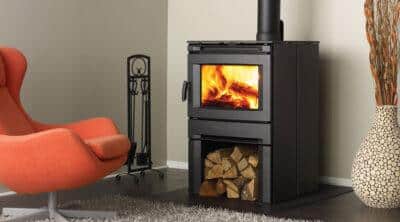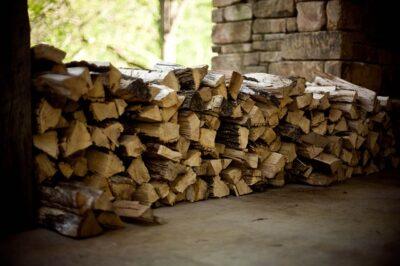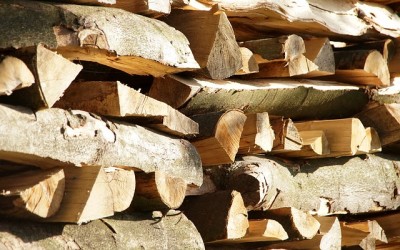Anyone living in a forested area with sufficient acreage and access should consider a wood-burning stove as a heating source. The challenge, though, is knowing which wood burns best, hottest and the longest.
Some soft woods like birch and pine burn easily but also burn very fast and very hot. They also produce significant creosote in chimneys and flues. Other woods like oak and maple are hard woods that burn hot and long, but often need a little help getting started from a soft wood like ash or birch.
There are five fundamental factors that determine the quality of any wood for burning in a wood stove.
- Moisture content. Some woods are simply “wetter” than others. All fresh woods (trees with leaves of needles still attached) need to be seasoned for at least a year. Deadfalls and standing dead trees can be burned immediately if they are sufficiently dry.
- Hardness. Some woods are harder than others. Typically, a hard wood is preferable because it burns slower and longer. However, they are difficult to get going initially and often require a mix of some soft woods to get the fire going.
- Resin. Resinous woods include pine, birch, aspen and eucalyptus. They tend to be softer woods and burn hot and fast. They also produce significant creosote and will sometimes impart black smoke. They’re OK for getting a fire started, but less than desirable for long-term heating.
- Sparking and spitting. Some woods such as pine and aspen spark and spit coals while burning. Not a problem in an enclosed firebox, but stirring the fire or adding more wood could cause some sparking and spitting.
- Split ability. Most wood for a wood-burning stove needs to be split. Some woods like ash split very easily while other woods like Osage orange are almost impossible to split.
In order to help you sort out the various strengths and weaknesses of assorted woods, here’s a cheat sheet to give you some guidance. The wood types are graded from A to D. “A” is the best and “D” is the worst.
These Solar Backup Generators Deliver 4 Times More Power Than Other Models!
Alder (Grade D) — A low-quality firewood that burns fast and is highly resinous.
Apple (Grade B) — Requires seasoning but does not spark or spit. A medium-hard wood.
Ash (Grade A) — Somewhat soft but a very low water content of 50 percent actually allows it to be burned green. Burns at a fairly steady rate and is easy to split.
Beech (Grade B) — Burns reasonably well when properly seasoned.
Birch (Grade B) — A great way to start a fire but burns very fast and emits significant creosote.
Cedar (Grade C) — Splits easy and burns hot and somewhat fast. Little sparking or spitting. Also resinous, leading to creosote buildup.
Cherry (Grade B) — Burns well if properly seasoned. Doesn’t spark or spit.
Elm (Grade C) — A curiously low grade for a hardwood but it has one of the highest water contents of any tree (140 percent). Seasoning is critical. Burns long but can be hard to split.
Eucalyptus (Grade C) — Highly resinous and burns fast. Hard to split. Does not spark or spit.
Hawthorn (Grade B) — A generally good firewood that burns well.
Hazel (Grade B) — Requires seasoning. Burns fast but does not spark or spit.
New Survival Energy Product Makes Every Window A Powerful Solar Charger
Horse Chestnut (Grade D) — Save it for the fire in the backyard. Hard to split and nearly impossible to burn even with other soft woods.
Larch (Grade D) — Hard to split and is highly resinous. Spits and sparks excessively.
Mulberry (Grade B) — A good hardwood but hard to split. Easier to split when seasoned after a year.
Oak (Grade A) — One of the hero fire woods. Low moisture but does require seasoning. Burns low and slow.
Pine (Grade D) — Good for starting a fire but needs seasoning and burns like paper. Also builds up creosote if not fully seasoned.
Poplar (Grade D) — A very soft wood that’s good for starting a fire but not much else. Burns very hot and fast.
Walnut (Grade C) — You would think this hard wood would do better, but it’s very hard to split and just doesn’t seem to want to burn.
Willow (Grade B) — Another wood with a high water content that needs long seasoning. Burns fairly well but needs other soft woods to get the fire started.
Ultimately, you have to burn what you have on hand. Hopefully you have a variety of tree species and options and the ability to season your wood or find deadfalls. In the end, heat is all that matters, but the wood that provides that heat could make a big differenc
What are your favorite woods for stoves? Share your advice in the section below:
 Off The Grid News Better Ideas For Off The Grid Living
Off The Grid News Better Ideas For Off The Grid Living






